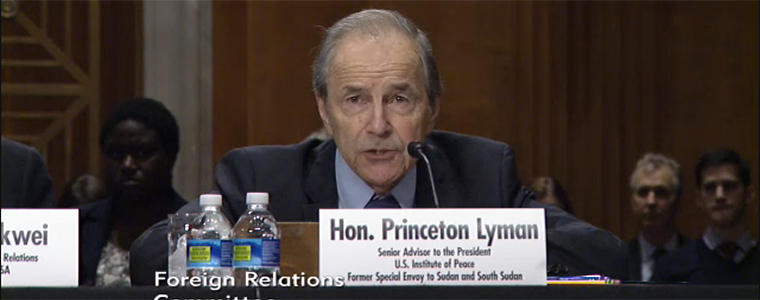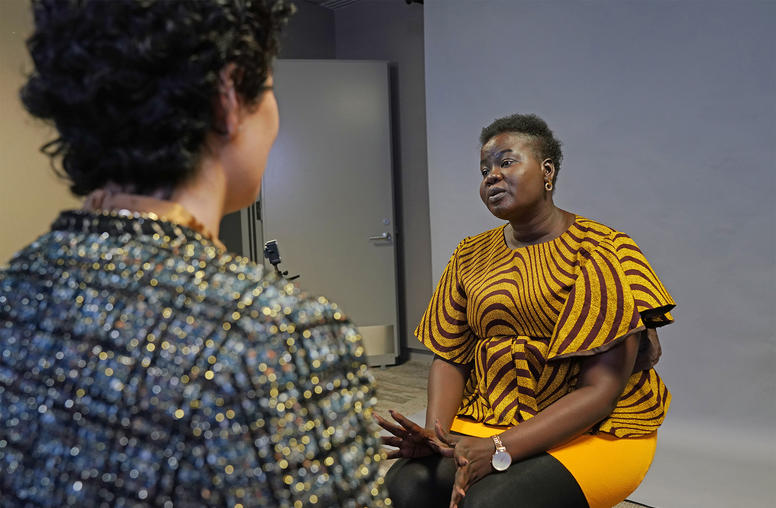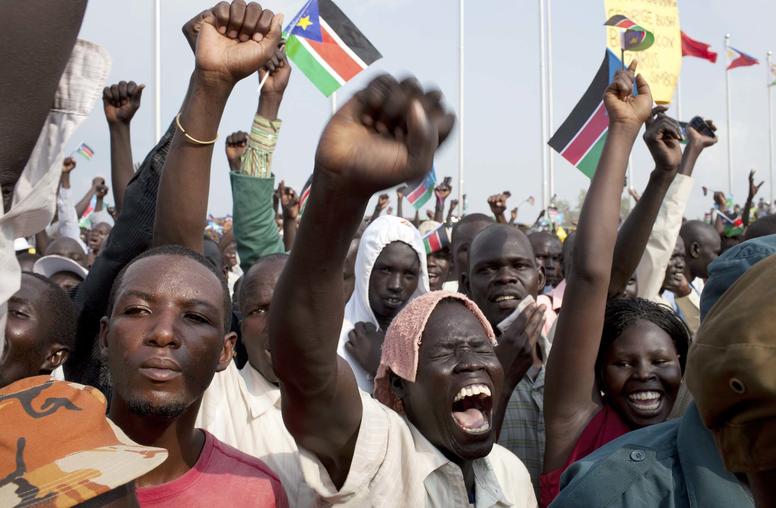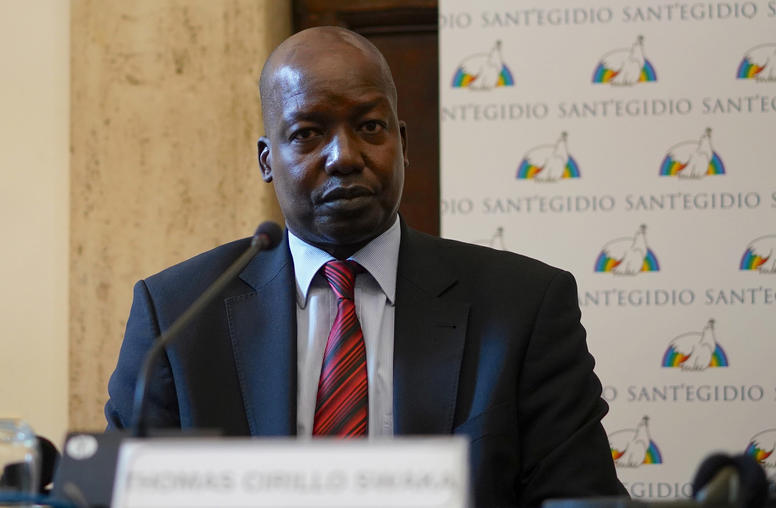Independent South Sudan: A Failure of Leadership
Testimony before the Senate Foreign Relations Committee
Princeton N. Lyman, senior advisor to the president at USIP, testimony before the Senate Foreign Relations Committee.

Chairman Corker, Ranking Member Cardin, and members of the Senate Foreign Relations Committee, thank you for holding this hearing. It is an honor to appear before you today to present my views on the current civil war in South Sudan and how it may be brought to a close. The views I express today are my own and not necessarily those of the U.S. Institute of Peace (USIP), which does not take policy positions.
Overview
The civil war in South Sudan is one of the great tragedies in the world today. It also is undermining the stability of one of the most sensitive regions in the world, the Horn of Africa. Indeed, it is for that reason that the United States has been strongly engaged over more than a decade to bring peace to what is now Sudan and South Sudan. That commitment was exemplified with President George W. Bush’s appointment in 2004 of former Senator John Danforth as Special Envoy for Sudan, to help bring about the Comprehensive Peace Agreement (CPA) that ended the war between the north and south of Sudan that had gone on for more than seventeen years. The U.S. commitment continued under President Obama with similar senior level appointments and with constant and close U.S. attention to implementing the CPA, the culmination of which was South Sudan’s gaining, peacefully, its independence in 2011.
U.S. engagement is no less critical now as it has been in the past in addressing this new crisis. I can imagine the feeling of despair and indeed anger in the U.S., especially among the long-time supporters of the Sudan peace process, that the leaders of South Sudan have so betrayed their people and wasted the opportunity that independence provided. That makes it harder to gear up for even more effort by the U.S. But the needs of the South Sudanese people are great with nearly 2 million people displaced and more than 7 million in desperate need of food aid. The U.S. already has spent more than $1 billion on humanitarian assistance in this situation. The threats to regional stability are also no less great than in the past when this area was engulfed in war. We are, finally, invested in this process. Walking back would be morally wrong.
The African Lead
But our role as in the past is integrally linked to what the Africans do. It was the neighboring African countries who led the negotiations of the CPA and enabled us to play our role in support. It was the Africa Union’s High Level Implementation Panel, led by former South African President Thabo Mbeki, which led the hard but ultimately successful negotiations implementing the CPA, to which again the U.S. could thus lend strong support.
Today the neighboring African countries under the Intergovernmental Authority on Development (IGAD) lead the peace process in South Sudan backed by the Africa Union and other AU members. African leadership is an essential element in bringing about peace. For it is the African countries, especially the neighbors, who are most affected by the crisis and who are also in the best position to enforce whatever international pressures are placed on the parties. Moreover, it is clear from past experience that if the African countries in a crisis situation are divided, the UN Security Council will be similarly divided on the steps to be taken, or even if united be unable to enforce any strong sanctions on the parties.
Unfortunately, IGAD is divided over this current crisis, making it difficult for it to take strong action. Though it frequently threatened an arms embargo and other sanctions on the contending parties it never reached consensus on them and never recommended such to the UN Security Council. Members Uganda and Sudan are sharply divided politically and for a time have used the situation to carry out a proxy war between them. Ethiopia and Kenya have differed at times over how to move the peace process forward. Several of the members, and/or their private sectors, are involved in the arms trade or other economic activities that militated against supporting economic sanctions or an arms embargo. Somewhat to address these problems, the AU created IGAD Plus Five, adding other African countries to the process, which has helped in some ways to get more traction but added new and sometimes competing processes to the mix. Finally IGAD Plus was created which opens the door to broader international participation, including the U.S., UK, Norway, China, the Arab League, and others.
Despite its problems, IGAD has achieved much. It began with an impressively comprehensive approach to what would be required to bring lasting peace to South Sudan. It envisioned a broadly based process of political transformation covering reform of most of the political, social, and economic institutions of the country. Little by little, however, as the contending parties proved unresponsive to every effort to stop the fighting, breaking every cease fire agreement and proving impervious to threats of sanctions and punishment, IGAD moved to what might be described as a lowest common denominator for a peace process. That is, the two contenders – Salva Kiir and Riek Machar – would be called upon to come together once more in a government of national unity and work out together the changes necessary. IGAD has put together, painstakingly, this peace agreement which both sides have now signed.
It is still on paper a most comprehensive agreement. It includes the fundamental transformational changes necessary for a lasting peace. But it is extremely fragile. It depends too heavily on the cooperation and commitment of the contending parties, especially the leaders Kiir and Machar to implement these far reaching reforms, but who in fact have little incentive to do so. It sets out transformational processes and procedures which are commendable but which cannot possibly be accomplished in the time frames proposed. Most important, these reforms are unlikely to be implemented without strong international involvement. It is thus so fragile as to be doubtful of success. But it is the only peace process under way. Doing everything possible to make it work is thus the best thing we can now do.
Fundamental Weaknesses That Threaten the Agreement
As you know I served as the U.S. Special Envoy for Sudan and South Sudan from March 2011 to March 2013. I have spent many hours and sleepless nights seeking to understand what went wrong in South Sudan, and why the hopes and dreams of the South Sudanese people have been so tragically betrayed. But I do not want to provide a history here today nor attempt a full examination of what went wrong. That will be important over time, especially for our understanding of peace processes in the future. I do however want to point to those causes of the conflict that bear on the potential for resolving it, and in particular on the peace agreement which the parties have recently signed.
I commend to the attention of all those concerned with this crisis the report of the Africa Union’s Commission of Inquiry on South Sudan, headed by former Nigerian President Olusegun Obasanjo. That report is hard to read because it lays out in horrific detail the human rights violations – committed by both sides -- in this conflict. But the report is more than that. The authors undertook a careful and extensive examination of the institutions that should have been bulwarks against the outbreak of civil war – the ruling party (SPLM), the legislature, the judiciary, the military, the police, and civil society. All of them were inadequate to the challenge of keeping the rivalries among the leaders from spinning out of control. Of those I want to emphasize two: the ruling party and the military. Without understanding the weaknesses of those institutions, the peace agreement as now configured will almost surely fail.
The SPLM
The Sudan People’s Liberation Movement (SPLM) emerged during the second of South Sudan’s revolt against the north as the dominant party in the south. But South Sudan did not win its independence largely through a political process as much as a military one. Throughout the civil war, the dominant institution in the revolt was the Sudan People’s Liberation Army (SPLA) and the various factions and militia that eventually unified under it. All the leaders of the SPLM have been drawn from the military. That remained true after independence. In sum, the independence movement in South Sudan, embodied in the SPLM, was a military one with a weak political wing. By contrast in South Africa the anti-apartheid movement was largely a political one, fueled indeed by civic action and civil violence, but the ANC – the leading party -- was inherently a political institution with only a small military wing. The African National Congress (ANC) has thus been able to manage its political rivalries – every much as challenging – within the structures of the party and without national upheaval.
The SPLM does have important symbolic and national importance in South Sudan. But its weakness as a political institution was revealed when Vice President Riek Machar indicated his intentional in 2012 to challenge President Salva Kiir first for leadership of the party and subsequently for the presidency. Given the history of Machar in the 1990s and the reported slaughter of Dinka when he was leading a revolt against the SPLA at that time, this was a fundamental challenge, reviving ethnic rivalries and bitter memories. It was a crisis that would try the capabilities of a sophisticated political party. But in the case of the SPLM, the party mechanisms were far too easily set aside by the President. Bypassing the party machinery, suspending its Secretary-General, and taking an aggressive military response to the challenge, Kiir made the party largely irrelevant.
I raise this because there is some hope, pressed largely by South Africa and Tanzania that the SPLM could serve as the unifying institution in South Sudan, overcoming the fissures that developed between President Kiir and Vice President Machar. This was the basis of the so-called Arusha process, which operated parallel to that of IGAD and developed a set of principles that would allow for a new reunified SPLM government as a vehicle for peace and for reform. But the SPLM as a political institution does not have either the political support among the contending forces in South Sudan nor real dedication to common principles, especially to the principles of party democracy, for such a process to succeed. As has quickly become evident, the government of President Kiir has not honored the principles agreed in the Arusha process and the former Secretary-General of the SPLM – Pagan Amun – who championed the Arusha approach, is once again in exile. The SPLM may have an important role in the future political dispensation in South Sudan, but it is not able at this time to be the principal political vehicle for either peace or reconciliation.
The SPLA
The Sudan People’s Liberation Army (SPLA) is the other institution that might have been expected to provide a sense of national unity and stepped in to prevent the breakdown that occurred. But throughout the Sudan-South Sudan civil war, there was in fact little unity among the South Sudanese fighting units. Abetted in many cases by Khartoum, various militias, usually ethnically based, broke with the main SPLA/SPLM and fought against it. In the run-up to the referendum on South Sudan’s right of self-determination, Salva Kiir did a remarkable job of bringing all these various units together in support of independence and as part of a single national army. But it was an incomplete unity. The various entities were enticed in by generous payments and high ranks for the leaders, and little integration of forces. As pointed in the Commission for Inquiry, the SPLA had as many as 700 generals. Units with few exceptions remained ethnically based. Loyalty to the national army was fragile, with some militia going in and out of the system, requiring new negotiations, new payments, and new tentative agreements.
As the tension between President Kiir and Vice President Machar grew in 2012, President Kiir began creating a special Presidential Guard made up of people from his home area, and outside regular army control. This only exacerbated the divisions within the SPLA. In the aftermath of the events of December 2013, the SPLA fractured along ethnic lines with Neur and Murle based units decamping to the opposition under Riek Machar.
The point here is that the SPLA, either in its present form or recreated into the “unified” form as before the current civil war, cannot act as unifying institution. Security sector reform, creating a truly national army loyal to the state not to a single party or leader, is of course desirable, and is included in the plans of the peace agreement. But such reform will be extremely difficult to undertake given the composition of current units, the attitudes of today’s leaders, and the lack of a unifying national political narrative or institution. That means that security for the peace process must come largely from outside.
Implications for the Peace Agreement
There are three conclusions from this analysis.
- One is that African countries and institutions – IGAD, the IGAD Plus Five, the AU Peace and Security Commission, the AU Commission -- have to be united and firm in enforcing this agreement on the parties.
- Second, additional security must be provided to protect the proposed government of national unity and the reform process, as well as civilians caught up in the war.
- Third, only the international community can assure that the transformational aspects of the agreement – constitutional change, free elections, justice, protection of human rights and free speech, active civil society participation, reconciliation, economic and financial transparency and accountability, and security sector reform –will be acted upon. Neither of the leading contenders – Salva Kiir nor Riek Machar – have a stake in these processes. Indeed they will find them threatening to their continued and rivalling ambitions for the presidency of the country.
Thus there is a need for stronger action from Africa, the UN, and the U.S.
Africa’s Role
The peace agreement will only succeed if the AU and its members are prepared to enforce it. The agreement provides for a high level Joint Monitoring and Evaluation Committee, headed by former Botswana President Festus Moghae. To be effective in this role, Moghae should be accorded by the AU the authority of a High Commissioner, someone who can call the parties to order, demand performance, veto bad appointments, make his own appointments when there is inaction, and recommend as necessary sanctions or other pressures upon the parties. He must especially have authority over the financial and budgetary processes of the transitional government, for corruption and financial irregularity rank as among the most destabilizing and dishonorable aspects of the government including when Kiir and Machar were tougher in office. This is a tall order for the AU, but it is essential.
Second, the AU must select urgently the Judge of the Hybrid Court that is to address issues of justice arising out of the Commission of inquiry and its conclusions that crimes against humanity have been committed. Working hand in hand, President Moghae and the Hybrid Court can wield the necessary influence to force transformational change upon the parties.
Third, the AU must strengthen quickly the Ceasefire Transitional Security Arrangements Monitoring Mechanism (CTSAMM) which is to monitor the cease fire, cantonment of troops, and related matters. The CTSAMM moreover must add women to its ranks to assure that gender issues are being addressed in a context where much gender-based violence has and continues to take place. Its reports, which are to be made public, should provide the basis for firm action by IGAD, the AU and as appropriate the UNSC. Fourth the AU must conclude that security in Juba, a sine qua non for establishing the government of national unity, requires more than the security forces of the parties and creation of joint police units, as now envisioned in the security agreement. These security institutions are part of the problem and are very unlikely to work in concert or objectively. Right now not only has the opposition leader not come to Juba, but the arrangements for his doing so, with his own security contingent, is almost a predictor of violence. An enhancement of the UN Mission to South Sudan (UNMISS), or a related AU force is necessary.
The UN Role
UNMISS has done an extraordinary job in the midst of this conflict. Some 200,000 civilians have been taken into UNMISS camps for protection and defended against attacks by belligerents. In spite of harassment and being shot at by forces from both sides in the conflict, UNMISS continues to send out patrols, facilitate humanitarian aid, and as much as possible protect the 1.7 million displaced. It is shocking that the Government of South Sudan continues as it has for several years to speak out against UNMISS, have its forces fire on UN peacekeepers, and to denigrate its work.
The UNSC is scheduled to renew UNMISS’s mandate this month. In doing so, it should expand the mandate to allow UNMISS to play a more active role in the securitization of Juba, and reinforce its protection mandate. Further, the UNSC should put the leaders of the SPLM and the SPLM/IO on notice in the strongest possible terms that any attack on UN peacekeepers is a war crime and will be investigated and adjudicated. The same should apply to attacks on aid workers, 41 of whom have been killed since December 2013.
The U.S. Role
The U.S. will have to continue to play a major role in alleviating the humanitarian crisis caused by the war. Without that, there is little hope for the people of this war-torn country. The dedicated work of the U.S. Special Envoy, Ambassador Donald Booth, and his team has contributed greatly to the progress that has been made toward a peace agreement and their work must continue as well with strong support from the White House. But there is more that must be done to bring about an end to the war.
How can the U.S. be most effective? We have a good example from President Obama’s actions during his visit to the AU in Addis in July. Obama took the opportunity to call together the leaders of IGAD and the contending parties and urge them to find agreement on a peace plan. He made it clear that the U.S. was prepared to add sanctions of its own on the leaders of the war, and to press for such from the UNSC if agreement was not reached. The meeting created more urgency and purpose within IGAD and helped bring about the peace agreement recently signed. As progress on implementing the peace agreement drags on – the lack of adequate security in Juba, the failure yet to create a government of national unity, the delay in appointments for the Hybrid Court, etc. – there is again need for high level U.S. pressure. At the next meeting of the IGAD Plus, Vice President Joseph Biden, should attend, He should inject the same level of urgency, readiness for U.S. actions, and support, that President Obama provided in Addis.
Second, the U.S. should be prepared to provide support to exactly those transformational elements of the peace agreement that are most in danger of being ignored. Many civilians who have been pushed aside by the war, and many more displaced from their homes, would be ready and willing to contribute to this process. The World Bank pointed out some years ago that more than half of peace agreements fail with the parties going back to war. One element in success is the participation of broad elements of society, not just the “guys with the guns.” The Institute of Inclusive Security points out that the percentage of peace agreements that succeed rises dramatically to the extent that women are involved. Yet including civil society and meaningful women’s participation in the peace process is always difficult. It is resisted by the belligerents, is often inhibited by lack of organization and skill by civil society, and is often set aside by mediators fixed upon getting the contending parties – the “guys with the guns” -- to the table. The U.S. should provide financial and political support for civil society, women’s groups and individuals, for the professionals assigned to constitution drafting committees and judicial reform, and for economic reform institutions, reconciliation processes, and other aspects of participation of non-belligerents in the transformation process.
Finally, the U.S. should defend strongly a free media – something the Government of South Sudan has drastically curtailed over the past three years. Since as early as 2012, journalist in South Sudan have been harassed, beaten and in some cases assassinated. As one recent example, the Free Voice, a peace programming group partnered with the U.S. Institute of Peace, was shut down despite it having no partisan leanings. A leading newspaper was shut down at the same time. These practices must be stopped and the perpetrators punished. With limited other outlets for expression of opinion and accountability, a free media is an essential adjunct to this peace agreement.
And if it fails …
Given all its problems and fragility, this peace agreement may collapse. Even now fighting and atrocities continue. If it fails then the issue must be raised to an even higher level.
The issue must become the subject of a heads of state level meeting at the UN, with the strong participation of the U.S., along with major African heads of State, AU leaders, our European partners and major humanitarian organizations. There should be an agreement at that meeting on a series of steps to restrict the fighting, such as an arms embargo, a trade embargo (excepting food and medicine), a ban on access to financial institutions by the contending parties, if possible with China’s and Sudan’ support placing further oil proceeds for the government in an escrow account, and the beginning of investigation and adjudication of war crimes by the proposed Hybrid Court. Neighboring African states would have to agree to enforce the arms and trade bans and refrain from any armed or financial support to either of the parties. A joint UN/AU mediation would then be charged with reinstituting a stronger peace plan.
This is a tall order. It would require considerable high level and intensive diplomacy. But only by this level and degree of international unity could this war be brought under control should the current peace plan fail.
Thank you, Senators. I am happy to answer your questions.
The views expressed in this testimony are those of the author and not the U.S. Institute of Peace, which does not take policy positions.



